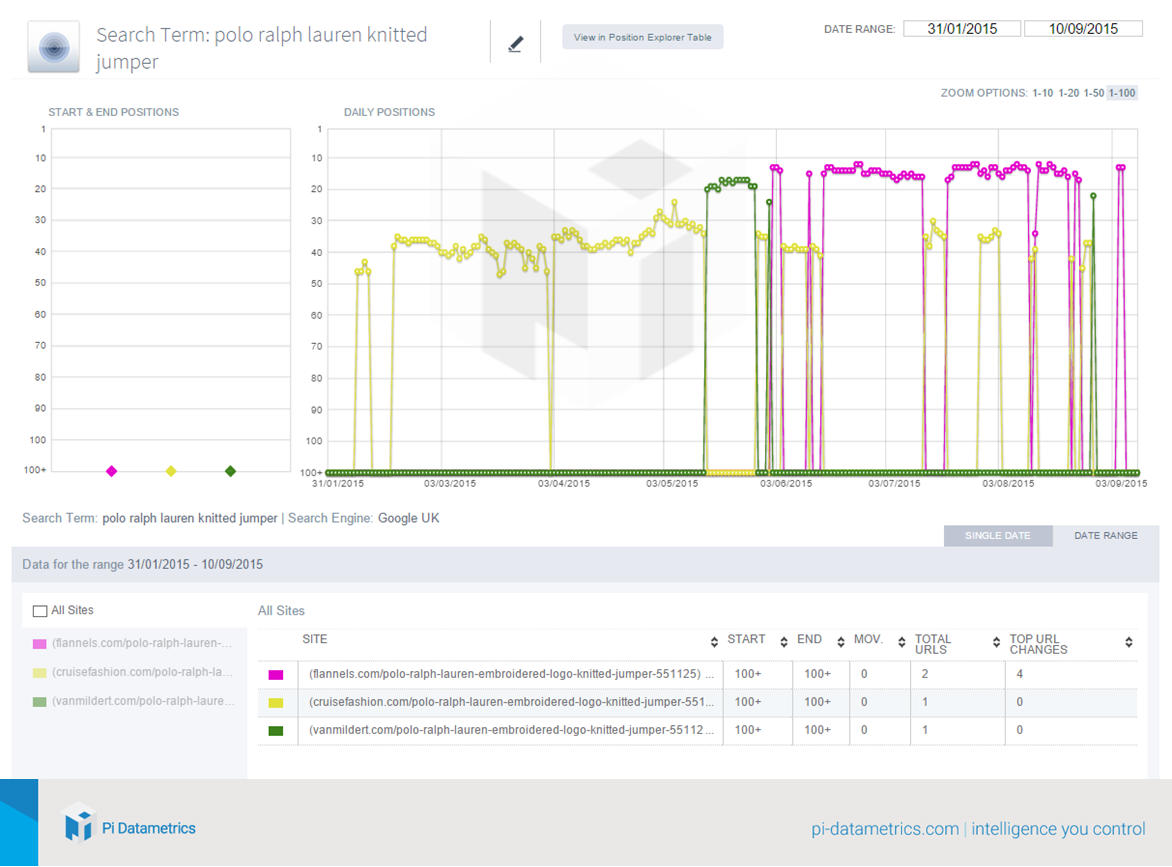In this post I’ll look at how ecommerce sites are being penalised in Google SERPs for having duplicate content…
1. Sports Direct and the Ralph Lauren jumper
Let’s look at one example. Below you’ll see remarkably similar webpages from three of Sports Direct’s brands, Cruise, Flannels and Van Mildert.
Each page is advertising the same product, using the same URL structure (/polo-ralph-lauren-embroidered-logo-knitted-jumper/551125/) and the same product copy. These pages are live at time of writing, so feel free to go check them out.
So what does Google think?
This is obviously an extreme case. The websites in this example are very similar and intentionally so. Sports Direct is keeping costs down by using the same creative and web infrastructure across multiple brands and domains.
But, using analysis from Intelligent Positioning, we can look at the ranking of these three pages for the phrase ‘polo ralph lauren knitted jumper’ and see that these websites are suffering the consequences of such similar content.
There can be only one, as each page is periodically ‘dislodged’ by another. The Flannels page has ranked highest (between 10 and 20) for the past three months but during this time has suffered daily or weekly drops to 100+ in the SERPs.
(click to enlarge)
And what should we take from this?
If you are a content manager working for a reseller, you have to make sure that those creating product pages are doing so responsibly.
Newbies must be properly trained on the basics of SEO, from metadata to URL structure and on-page elements.
Encourage writers to take the time to create their own product copy, the more copious, the better. Product copy doesn’t have to be boring, it can be as rich as proper editorial.
The more unique the content is, the better. Of course, if you’re in the position of Sports Direct, you have to be doubly careful (running two sites with an overlapping product range).
Sam Silverwood-Cope, director, Intelligent Positioning, points out that content creators must track their terms to keep abreast of search performance. Stolen content can then be reported to Google or a writer’s own misguided work or errors can be corrected.
Having content stolen can be an extremely frustrating and costly issue. It looks like there is a flaw in Google’s algorithm when it deals with duplicate content.
The best thing to do is track your terms and see if others are harming your site. You can only see this flipping of positions if you have daily URL tracking. If you see unexplained fluctuations, then digging deeper, ultimately you can report the abuser to Google.
2. 8×8 and the call centre software
Here’s another example, this time from the B2B world.
The top screenshot shows the original content on the 8×8 website. The one below shows the reseller, advertising the 8×8 product and using copy and imagery taken from the original.
8×8 webpage
8×8 reseller webpage
We can see the same position switching in the SERPs
This time the problem occurs often only for a day at a time, the reseller jumping above 8×8, which loses five or 10 positions in the SERPs for the phrase ‘contact centre software integration‘.
The solution here has to be found by the brand. 8×8 must be more aware of reseller activity, both their site content and their comparative rankings.
Unless content is unique, there’s always the chance that the sum of the parts for this brand and its resellers might not be quite as large as it could be when it comes to search.
(Click to enlarge)
For more information on SEO, read the Econsultancy SEO Best Practice Guide.








Comments